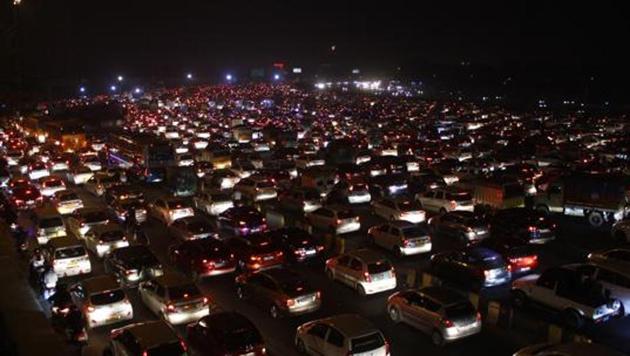Gurugram traffic cops locating, timing and recording jams to decongest city
The Gurugram police from December 31, 2018, started recording traffic jams in the city, including the duration, reason and time taken to clear it, to identify choke points and find long-term solutions to traffic snarls.
The longest traffic jam in the city in January lasted two hours, at the Delhi-Gurugram border on the expressway, and at Basai Chowk on different days, according to Gurugram police data.

The city police from December 31, 2018, started recording traffic jams in the city, including the duration, reason and time taken to clear it, to identify choke points and find long-term solutions to traffic snarls.
Earlier, when a traffic jam was reported, traffic control room used to inform the traffic police personnel on the ground to clear the roads, but the data was never recorded.
Besides the above mentioned locations, hour-long traffic jams were witnessed once each at Khandsa Chowk and Bhaktawar Chowk on January 10, and at Himgiri Chowk on January 25. Also, the largest number of traffic jams were recorded at the Delhi-Gurugram border on the expressway (21), followed by Basai Chowk (18) and Tikri exit on Sohna Road (15).
The two-hour block at the border was reported on January 23, from 6.20pm to 8.20pm, due to heavy vehicular flow on the Delhi side, according to the data of the city police. The two-hour jam at Basai Chowk was reported on the intervening night of January 22 and 23, from 11.30 pm to 1.30 am, due to waterlogging and ongoing works, as per police records.
What now?
“The reason for traffic jams at each location varies. We are looking into it to find solutions, both in terms of infrastructure and increasing deployment,” said Himanshu Garg, deputy commissioner of police (DCP), traffic. He said that they would analyse the data and look for long-term solutions, such as setting up barriers or creating U-turns.
A traffic police official privy to the development said that the traffic police has scheduled a meeting with the Gurugram Metropolitan Development Authority later this month to discuss problems leading to traffic jams. The DCP held a meeting last week with traffic inspectors on the issue of traffic jams.
“On Gurugram side of the border, the highway has 16 lanes, which becomes four lanes when it reaches Rajokri flyover in Delhi. This creates a bottleneck and traffic jams take place in the evening rush hours,” said Rajesh Kumar, traffic inspector of the area.
Kumar said that the authorities in Delhi should increase the width of service lanes to accommodate the traffic and reduce jams.
Rahul Dev, traffic inspector, under whose jurisdiction Basai Chowk falls, said that traffic jams are being caused at the intersection due to the PWD’s work of laying pipelines in the area. “Also, the road is not that wide and there is not enough space to widen it. The practical way is to increase the deployment and monitor traffic better,” the inspector said.
The initiative
Traffic jams reported by police officers, citizens and Google Maps are being recorded by the traffic control room round-the-clock. Police record the timings based on the data from Google Maps, by monitoring the stretch marked red on the application. Further, the police then contact officials on the ground to ascertain the reasons for the jams.
Citizens can report the traffic snarls on the traffic control room number 1905 and also tweet by tagging the traffic police’s official handle (@TrafficGGM). Whenever there is a jam, the zonal officers of the police convey the details to the control room over the wireless network or mobile phones, and also send the photo of the jam over WhatsApp. This is then compiled into a report at the control room.
For instance, a report in the case of a traffic jam reported at 6.40pm on January 3 at Signature Tower, which was cleared by 6.55 pm, states it was monitored through Google Maps and the ’reason’ was ‘accident of four cars near Signature Tower.’



